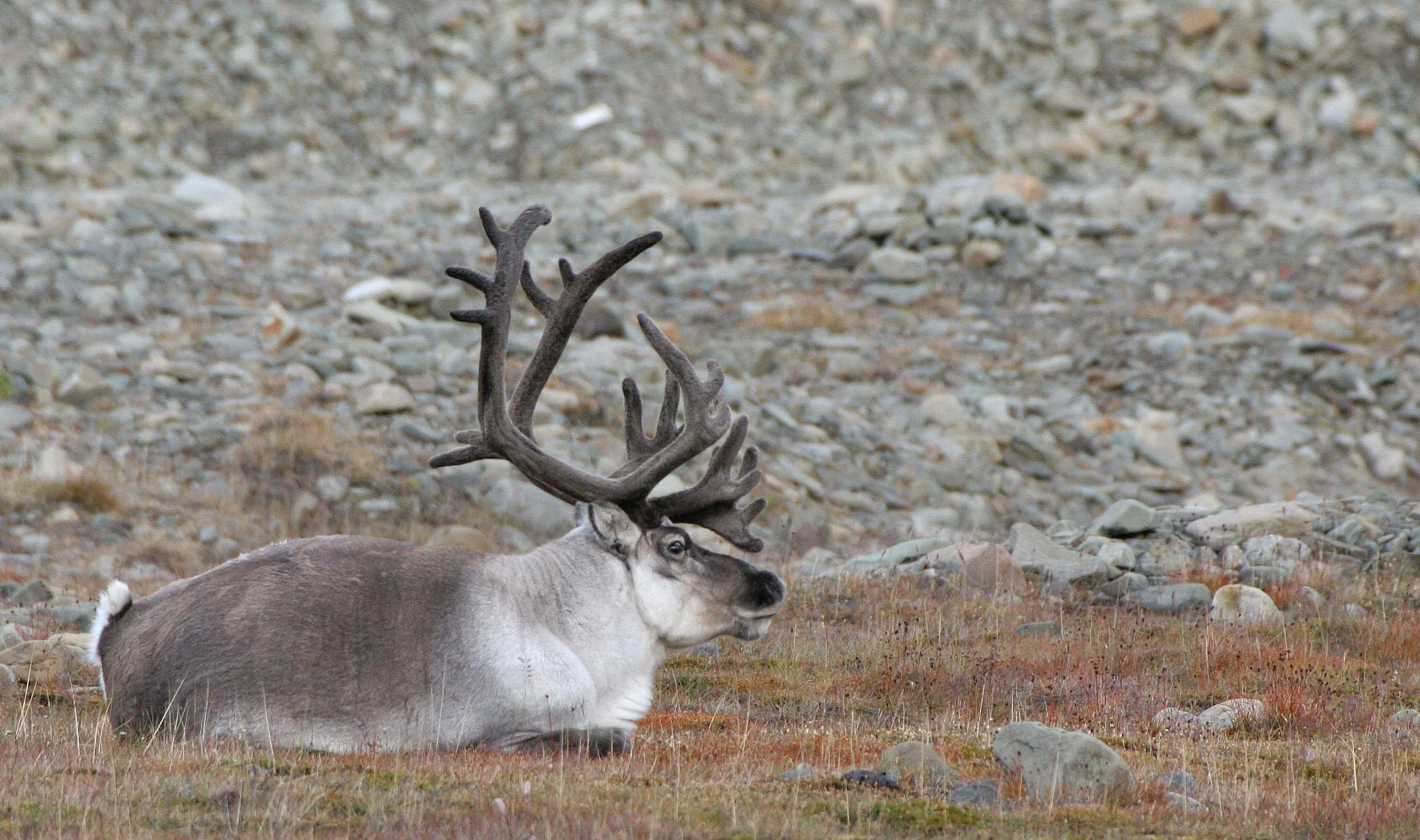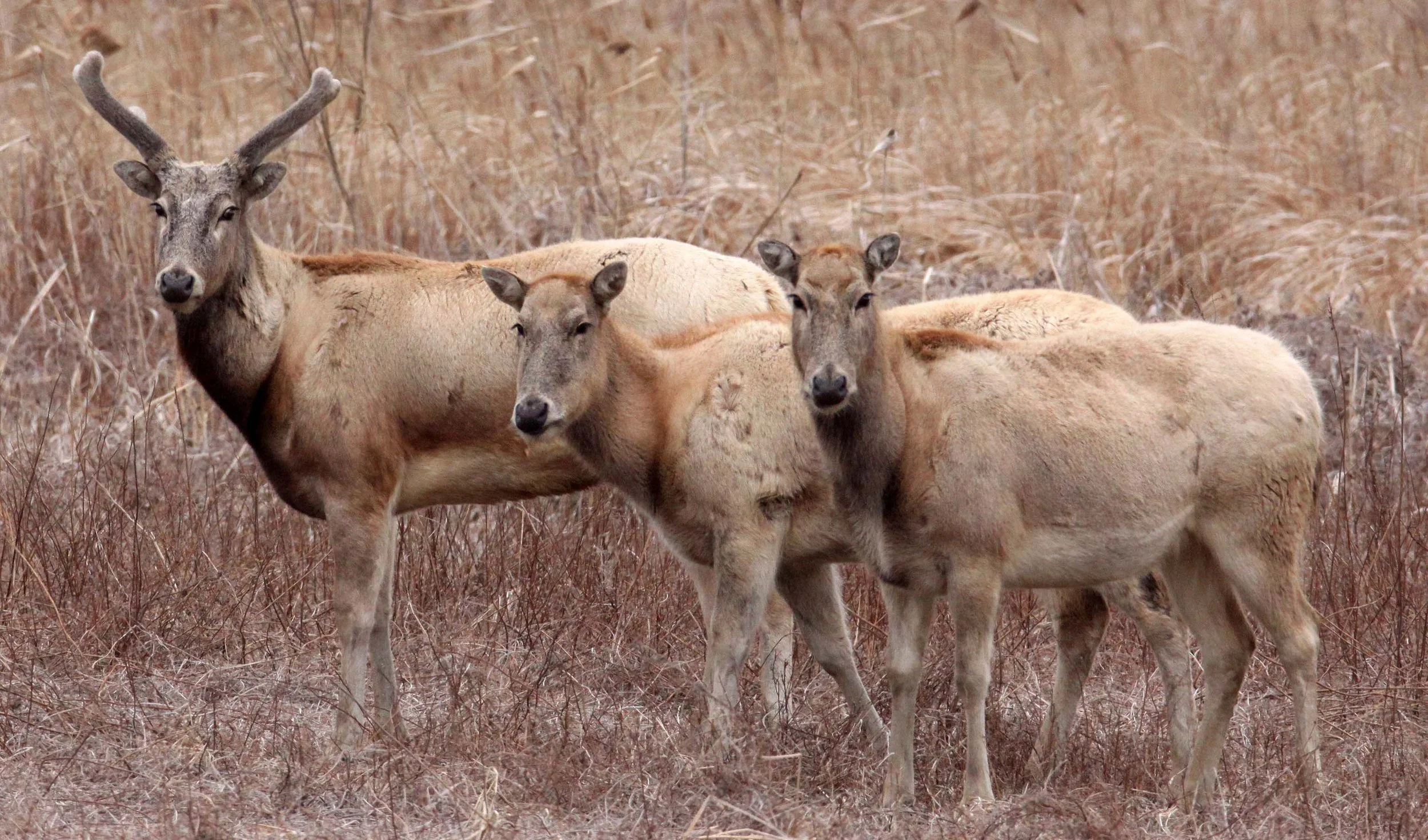Cervidae is a family of hoofed ruminant mammals in the order Artiodactyla. A member of this family is called a deer or a cervid. They are widespread throughout North and South America, Europe, and Asia, and are found in a wide variety of biomes. Cervids range in size from the 60 cm (24 in) long and 32 cm (13 in) tall pudú to the 3.4 m (11.2 ft) long and 3.4 m (11.2 ft) tall Moose. Most species do not have population estimates, though the Roe deer has a population size of approximately 15 million, while several are considered endangered or critically endangered with populations as low as 200. One species, Père David's deer, is extinct in the wild, and one, Schomburgk's deer, went extinct in 1938.
The fifty-four species of Cervidae are split into nineteen genera within two subfamilies: Capreolinae (New World deer) and Cervinae (Old World deer). Extinct species have also been placed into Capreolinae and Cervinae. More than one hundred extinct Cervidae species have been discovered, though due to ongoing research and discoveries the exact number and categorization is not fixed.
Subfamily Capreolinae (New World deer)
Tribe Alceini
Genus Alces: Moose
Tribe Capreolini
Genus Capreolus: Roe Deer
Genus Hydropotes: Water Deer
North American Moose (Alces alces) Utah
European Elk (Moose) (Alces alces alces) Norway
European Roe Deer (Capreolus capreolus) Italy
Siberian Roe Deer (Capreolus pygargus) Ussuriland Russia (live one seen but not photographed)
Chinese Water Deer (Hydropotes inermis) Eastern China
Siberian Roe Deer or Asian Roe Deer (Capreolus pygargus) Ruoergai County, Tibetan Plateau, Sichuan China
Tribe Odocoileini
Genus Blastocerus: Marsh Deer
Genus Hippocamelus: Taruca
Genus Mazama: Brockets
Genus Odocoileus: White-tailed Deer
Genus Odocoileus: Black-tailed Deer
Genus Rangifer: Reindeer & Caribou
Genus : Ozotoceros: Pampas Deer
Marsh Deer (Blastocerus dichotomus) Brazil
Taruca (Hippocamelus antisensis) Chile
Red Brocket (Mazama americana) Brazil
Gray Brocket (Mazama gouazoubira) Brazil
Andean White-tailed Deer (Odocoileus virginianus ustus) Ecuador
California Mule Deer (Odocoileus hemionus californicus) Sierra Nevada Mtns, California

Inyo Mule Deer (Odocoileus hemionus inyoensis) East Side Sierra
Rocky Mountain Mule Deer (Odocoileus hemionus hemionus) Utah
Desert Mule Deer (Odocoileus hemionus eremicus) Texas
Columbia Black-tailed Deer (Odocoileus hemionus columbianus) Olympic Peninsula, Washington
Coue's White-tailed Deer (Odocoileus virginianus couesi) Arizona
Northern White-tailed Deer (Odocoileus virginianus borealis) Chicago
Dakota White-tailed Deer (Odocoileus virginianus dakotensis) South Dakota
Svalbard Reindeer (Caribou) (Rangifer tarandus platyrhynchus) Svalbard
Norway Mountain Reindeer (Rangifer tarandus tarandus) Lappland Norway
Grant's Caribou (Porcupine Herd) (Rangifer tarandus granti) Denali Alaska
Finnish Forest Reindeer (Rangifer tarandus fennicus) Finland, domesticated
Pampas Deer (Ozotoceros bezoarticus bezoarticus) Brazil
Sitka Black-tailed Deer (Odocoileus hemionus sitkensis) British Columbia
Subfamily Cervinae (Old World deer)
Tribe Muntiacini
Genus Elaphodus: Tufted Deer
Genus Muntiacus: Muntjacs
Central China Tufted Deer (Elaphodus cephalophus ichangensis) Sichuan
Indochinese Red Muntjac (Muntiacus muntjak curvostylis) Thailand
Reeve's Muntjac (Muntiacus reevesi) China
Fea's Muntjac (Muntiacus feae) Thailand
Indian Muntjac (Muntiacus muntjak aureus) India
Bali Red Muntjac (Muntiacus muntjak nainggolani) Bali Barat
Forest Musk Deer (Moschus berezovskii) Labahe Nature Reserve, Sichuan China
Tribe Cervini
Genus Axis (Axis): Spotted Deer
Genus Axis (Hyelaphus): Hog Deer
Genus Cervus: Elk & European Red Deer
Genus Panolia: Eld’s Deer
Genus Dama: Fallow Deer
Genus Elaphurus: Pere David’s Deer
Genus Rucervus: Swamp Deer
Genus Rusa: Timor Deer
Indochinese Hog Deer (Axis (Hyelaphus) annamiticus ) Thailand
Indian Hog Deer (Axis (Hyelaphus) porcinus) Assam India
Sri Lankan Spotted Deer (Axis axis ceylonensis) Yala
Indian Chital or Spotted Deer (Axis axis axis) India
Rocky Mountain Elk (Cervus canadensis nelsoni) Colorado
Roosevelt Elk (Cervus canadensis roosevelti) Olympic Peninsula Washington
Tule Elk (Cervus canadensis nannodes) California
Thamin or Burmese Eld's Deer (Panolia eldii thamin) Huai Kha Khaeng Thailand
Siamese Eld's Deer (Panolia eldii siamensis) Thailand
Iberian Red Deer (Cervus elaphus hispanicus) Spain
Central European or Common Red Deer (Cervus elaphus hippelaphus) Italy
Central Asian Red Deer (Cervus hanglu) Labahe Nature Reserve, Sichuan China 2024
Barbary Stag or Atlas Deer (Cervus elaphus barbarus) Tunisia
Yarkand Deer (Cervus elaphus yarkandensis) Qinghai, China
Thorold's or White-lipped Deer (Cervus albirostris) Qinghai, China
Dama or Fallow Deer (Dama dama) Spain
Pere David's Deer (Elaphurus davidianus) Eastern China
Barasingha or Eastern Swamp Deer (Rucervus duvaucelii ranjitsinhi) Assam, India
Barasingha or Southern Swamp Deer (Rucervus duvaucelii branderi) Kanha India
Mainland Southeast Asian Sambar (Rusa unicolor cambojensis) Thailand
Indian Sambar (Rusa unicolor unicolor) Sri Lanka & India
Javan Rusa (Rusa timorensis russa) Java, Indonesia
Bornean Sambar (Rusa unicolor brooki) Sabah, Malaysia
Flores Island Rusa (Rusa timorensis floresiensis) Komodo Island
Bali Rusa (Rusa timorensis renschi) Bali, Indonesia
Hokkaido Sika Deer (Cervus nippon yesoensis) Japan
Southern China Sika Deer (Cervus nippon kopschi) Fujian
Japanese Sika Deer (Cervus nippon nippon) Honshu Japan
Manchurian Sika Deer (Cervus nippon mantchuricus) Priorya Russia




























































